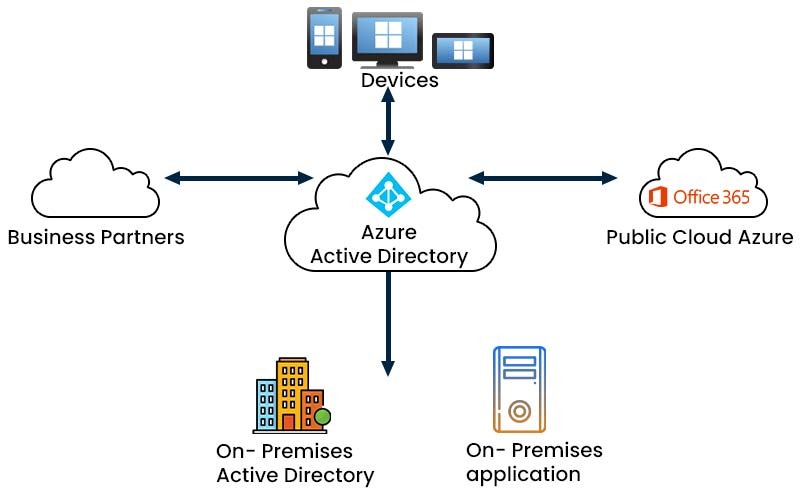Introduction
In the vast world of cloud computing, you must have heard of Microsoft Azure. But what exactly is Microsoft Azure? It is a cloud-computing platform and infrastructure that provides a wide range of cloud-based services, including power, storage, networking, and artificial intelligence. It helps businesses to build, deploy, and manage applications as well as services via Microsoft-managed data centers across the globe.
But, as you get more into the world of Azure, you will notice that there is more to it than just computing power and storage. That’s where Azure Active Directory (Azure AD) comes in. Previously known as Microsoft Azure Active Directory, this service has recently been rebranded as Microsoft Entra ID. So, don’t get confused if you see the new name being used. It is the same service. In this blog, you will learn about the active directory in Azure, its features, how it works, and the basic difference between Windows AD and Azure AD.
For those looking to deepen their Azure knowledge, consider pursuing PyNet Labs’ Microsoft AZ 900 and AZ 104 Combo Training. Let’s first understand what an active directory in Azure is.
What is Microsoft Azure Active Directory?
Azure Active Directory or Microsoft Entra ID is a cloud-based identity and access management solution. It offers a secure way to manage access to your applications and resources. It is known as the critical component of the Azure ecosystem. It is designed mainly to help you control who has access to your organization’s resources, both on-premises and in the cloud.
You can think of Azure AD as a gatekeeper that verifies the identity of users, devices, and applications. This will ensure that only authorized entities can access your resources.
Active Directory in Azure is not just limited to Azure-based applications. It can also be used to manage access to on-premises applications, Microsoft 365, and even third-party SaaS applications. This feature makes it a versatile solution that can be used across a wide range of scenarios.
Below, you can see the image for a better understanding.

Now that you have a basic understanding of Microsoft Azure active directory. Let’s now discuss some of the features that it can offer.
Features of Microsoft Azure Active Directory
Azure Active Directory offers many features and capabilities to help organizations manage identities and access. Some of the key features of Azure AD are:
- Identity and Access Management: Azure AD provides a robust identity and access management system that allows you to manage user identities, group memberships, and access to resources.
- Multi-Factor Authentication: Azure AD offers multi-factor authentication (MFA) capabilities that provide an additional layer of security to the authentication process.
- Conditional Access: With conditional access, you can set policies that grant or block access to resources based on user behaviour, location, and device compliance.
- Azure AD B2C: Azure AD B2C (Business-to-Consumer) is a specialized version of Azure AD. It is specially designed for consumer-facing applications. This will allow you to manage customer identities and provide personalized experiences.
- Azure AD B2B: Azure AD B2B (Business-to-Business) is a feature that allows you to manage partner and supplier identities. This, in return, provides secure access to your organization’s resources.
Now that you know what Azure AD is and its features. Let’s look into how it works.
How does Microsoft Azure Active Directory work?
Azure Active Directory (Azure AD) is a cloud-based identity and access management solution. It allows secure access to various applications, services, and resources. At its core, Azure AD operates on a flat, single-tenant structure, meaning that each organization has its own isolated instance, providing enhanced security and control. Let’s discuss the components of Microsoft Entra ID.
Users and Groups
Users and groups are essential components. Users represent individual identities, which can be employees, customers, or partners. These are created and managed within the Azure AD. Each user is assigned a unique identifier that allows them to access resources as well as applications. Meanwhile, Azure AD handles authentication, authorization, and account management.
When we talk about groups, we refer to collections of users that offer a convenient way to manage access and permissions to resources.
Custom Domains
Custom domains are also a key feature of Azure AD, enabling organizations to use their own branded domain names (e.g., pynetlabs.com) instead of the default Azure AD domain (e.g., pynetlabs.onmicrosoft.com). This customization enhances the user experience, making it easier for users to access applications and resources while maintaining a consistent brand identity.
By combining these elements, Azure AD provides a robust and scalable identity management solution, allowing organizations to securely manage access to their digital assets.
Let’s look into the basic differences between Azure AD and Windows AD to clarify their purposes and uses.
Difference Between Azure AD and Windows AD
Below, we have explained the difference between the Azure Active Directory and Windows AD in a tabular form based on different factors.
| Factor | Azure Active Directory | Windows Active Directory |
|---|---|---|
| Deployment Model | Cloud-based, multi-tenant | On-premises, single-tenant |
| User Management | Supports B2B and B2C scenarios, unlimited users | Limited to enterprise users, scalability issues |
| Architecture | Flat, distributed architecture | Hierarchical, domain-based architecture |
| Authentication | Supports multi-factor, password-less, and conditional access | Supports Kerberos, NTLM, and password-based authentication |
| Application Integration | Supports SaaS, custom, and on-premises apps | Supports on-premises apps, limited SaaS support |
| Desktops and Servers | Manages Azure Virtual Desktops and Windows 10/11 | Manages on-premises Windows desktops and servers |
These are the differences between the two.
Frequently Asked Questions
Q1 – What is the Azure Active Directory?
Azure Active Directory is a cloud-based identity management service that offers secure authentication, authorization, and identity protection for applications, devices, and users.
Q2 – What is the difference between Azure AD and Active Directory?
Azure Active Directory (Azure AD) is a cloud-based identity and access management solution, while Active Directory (AD) is an on-premises directory service for Windows domain networks.
Q3 – Why use Azure AD?
Azure can be used for many purposes. Some of the reasons to use Azure AD are:
- SSO (Single sign-on)
- Multi-factor authentication
- Conditional Access
- Identity protection
- Scalability & Reliability
Q4 – What is Active Directory used for?
Active Directory is used to authenticate and authorize users, manage access to resources, and store information about objects on a network.
Conclusion
Microsoft Azure Active Directory, now known as Microsoft Entra ID, is a powerful and comprehensive identity and access management solution. In this blog, you have studied Azure Active Directory, its features, how it works, and the basic difference between Azure AD and Windows AD.
As you learn more about Azure, always remember that Azure AD is a crucial component of the Azure ecosystem. Hence, it is important to understand its features in order to build a secure and scalable application.
So, the next time you hear someone mention Azure AD or Microsoft Entra ID, you will know exactly what they’re talking about. And who knows? You might just become an Azure AD expert yourself!





